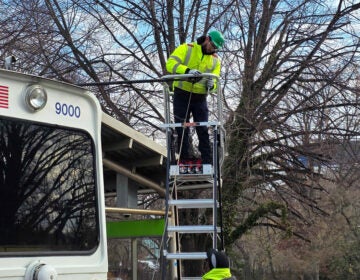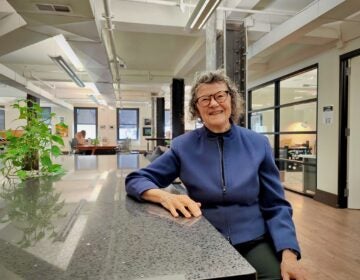Philly families face high-stakes hunt for prized charter school lottery slots
This is the first in a series of reports on one Philadelphia couple’s search for a school for their son.
It’s a snowy winter evening in Philadelphia’s Roxborough section.
Chris Byiers steps into the brightly lit lobby of Green Woods Charter School, hoping for the best.
Chris is among the three score or so parents who’ve shown up, looking to score big at the charter school’s annual lottery.
He and his wife, Jennifer, are in their early 40s and have a 4-year-old son named Jamie.
Jamie loves board games, Transformers and playing Superhero Soccer — a game he made up that combines two of his favorite things. And he needs a place to attend kindergarten next year. His mom and dad are hoping Green Woods might be the place.
Chris takes a seat at a table beside a friend who’s here for the same reason. A beanie hugs his head as he leans back, arms crossed, and jokes about how intense this whole process can be.
The math of tonight’s lottery is tough. The school has 75 slots for kindergarten. Applicants number 499. And under the school’s charter, as approved by the Philadelphia school system, a maximum of a quarter of the slots can go to kids like Jamie, who live outside the school’s core geographical zone, or catchment.
The parents crowd around cafeteria tables. It’s clear most have come directly from work that evening. They chat with one another about their strategies for finding a good school for their child.
Then Jean Wallace, the school’s CEO, stands up, a microphone in hand.
“This is a very bittersweet night for us.” she says. “This kind of outpouring of applications is reassurance for us of why we do what we do.”
Lottery night is emotional for Wallace.
“It’s very disheartening that we can’t meet the demand,” she’d said in an interview a couple days before.
One of many
The scene at Green Woods will be repeated around the city at a number of other high-demand charters this winter. Every year, the search for prized slots at attractive schools — charters, district-run magnets, private schools — becomes an obsession for hundreds of middle-class Philadelphia couples like Chris and Jennifer.
In Mt. Airy, where the Byiers family lives, as well as in Fishtown, Queen Village and other city neighborhoods where young couples flock, this high-stakes hunt becomes the dominant topic at most social gatherings.
Looking around Green Woods, you can see why a slot there is such a plum. Originally developed out of the Schuylkill Center for Environmental Education, the school now has a brand-new $13.5 million steel, stone and glass building on Domino Lane. Its 5.5 acres feature eight outdoor learning centers that together include a large pond, rain gardens, wetlands and a stream with a self-contained water system.
In short, it’s the place of parental dreams.
Wallace’s remarks end. The lights dim and an Excel spreadsheet gets projected onto a screen.
On the grid are the numbers that have been assigned to each student in a pool for a given grade. With a few keystrokes, the school’s registrar randomizes the list, finalizing the lottery for sixth grade slots.
Cellphones flash as parents take photos of the grid. (The full results will be posted online in two days.) Fingers dance over iPhones, texting the fateful number to partners and spouses.
For each grade, two lotteries are performed — one for the siblings of current students and one for students who have no such current tie to the school.
Chris faces a long wait. The most anticipated lottery, for kindergarten slots for kids like Jamie, will come last.
A familiar scene
For Chris and Jennifer, as for many parents in Philadelphia, tonight is just one milestone in a months-long journey of charter school lotteries, open houses, online forums and neighborhood meetings before coming to final decision about where to send their child to kindergarten.
For some — even those most committed to urban living — a disappointing end to that journey can lead to another trek: away from the city and out to a suburban district where full-time librarians, guidance counselors and nurses are a given.
In recent years, the district has cut faculty and administrative staff repeatedly in the face of decreased state funding. Without any additional funding, it faces an $80 million deficit for 2015-16 school year.
Recent proposals from Mayor Michael Nutter and Gov. Tom Wolf to raise the property tax by 9.34 percent and increase state spending on education by $2 billion over four years, respectively, would go a long way to help the drowning district.
For the Byiers family, who moved to Mt. Airy a little under four years ago, this has set up a constant internal conflict. They try to balance their lifelong belief in the value of public education with plain trepidation about the state of the Philadelphia School District.
For now, it doesn’t matter to them who is proposing what about school finances. They need to see change. Change that they can believe in will take more than three or four months.
But the timeline they are working on to choose Jamie’s school has only a few months left.
Their search for the right school absorbs way more of their attention than the mayor’s race that is gearing up at the same time.
Still, when asked about the politics of the schools, the couple says they would be happy to see an increase in property taxes if it means that the increase in city revenue would go toward the schools.
“You can’t bleed for change and then act outraged when that change comes,” as Jennifer puts it.
To an outsider — even one wary of the public schools — it might seem fairly simple: Why not at least give your neighborhood school a chance and then consider other options if you don’t like what you see?
In reality, that’s a tough road. However bleak the odds of getting a kindergarten slot at a place like Green Woods seem, they get even worse for subsequent grades.
At the Green Woods lottery, there were zero open spots in grades 1 to 6 on the night of the lottery. Why the lottery, then? The 647 parents who put in applications were vying merely for the best spots on the waiting list. Even when spots do open, the siblings of current students will receive priority placement.
The same goes at Greene Street Friends School — the private Quaker school where Jamie currently attends preschool. He’s guaranteed a spot there for kindergarten. The tuition: Just under $14,000. A year.
If Chris and Jennifer were to forsake Jamie’s spot, chances are slim that a space would open up for him in the future. Already, there’s a waiting list of families eager to take his spot.
When the couple sees Jamie at Greene Street, they feel good about the environment and the teachers.
“I drop him off and see a sunny classroom and smiling faces and I think to myself, ‘It’s Greene Street. It has to be Greene Street,'” Jennifer says one afternoon, sitting inside the warm and bright Malelani Cafe on Germantown Avenue, blocks from their home. She looks at Chris, who is nodding his head beside her.
Still, it’s a steep price. They can afford it, but paying that kind of tuition every year would certainly make their finances significantly tighter. Jennifer worries too, about a lack of diversity in private school.
Moving to Mt. Airy
Chris and Jennifer moved to Philadelphia from Brooklyn in 2011 seeking an urban environment that offered a more affordable, roomier lifestyle. Here, they can afford to live in a spacious Mt. Airy home that has a driveway, a yard for Jamie to run around in, and a porch that has space for extra firewood in the winter, all while technically still living in the city.
Jennifer works with the same financial services company she worked for in New York and can easily head to her Center City office on SEPTA’s Regional Rail or take the train to New York when she needs to. After years as a software engineer, Chris now has his own business as a personal trainer with clients all over the city.
The couple says they knew full well the reputation of the Philadelphia School District when they moved here. Still, they felt a strong and unwavering commitment to public schools.
They knew putting Jamie in public schools would involve lots of PTA meetings, fundraisers and volunteer hours. Jennifer says she expects it would be like taking on a part-time job, and she’s OK with that.
At the end of all that work though, she wonders if it would be enough — or if she would be sacrificing her child’s education for her principles.
“If you don’t like that question, or you don’t have that question, you haven’t been paying attention,” she said.
To Chris, who was born and raised in Mintlaw, Scotland — a small town about 30 miles north of Aberdeen — the concept of private schools, let alone a charter school, is foreign. There, everyone he knew went to the same school as him. They all walked home together, played together after school, sat in classes together and essentially, grew up together. Decades later, he can still rattle off their names.
That’s not the case on their Mt. Airy block, where none of their neighbors send their children to their local catchment school — C.W. Henry, a K to 8 elementary school adjacent to Weavers Way Co-op on Carpenter Lane.
Administrators at Henry boast of high levels of parental involvement, dedicated teachers, a Playworks recess program, a room full of up-to-date Apple computers and an innovative music and arts program.
Parents at Henry actively recruit other parents inside the catchment, trying to get them to commit to the public school. Chris and Jennifer have agreed to attend a meeting sponsored by the parents group Considering Henry.
“The sad thing for Jamie is that when he grows up, he won’t know the kids on the block, because no one goes to the same school,” Chris says.
“I said we were Henry, Henry, Henry for so long,” Jennifer says, sitting on her couch on a Wednesday afternoon. Jamie is nearby, playing word games on an iPad while staying warm under a blanket, blissfully unaware of yet another talk about schools.
He pipes in once during the conversation when he recognizes a snippet of the conversation. He talks about his friend Johnny, who already goes to C.W. Henry. He says he’d like to have his teacher next year.
Back and forth
As Jennifer says, the couple at one point strongly favored Henry. That is, until one day, they weren’t so convinced anymore.
Jennifer was browsing the day’s news and happened upon an article about Philadelphia public school ratings. In Northwest Philadelphia, C.W. Henry ranked sixth overall and third among traditional public schools. At the top of the list was Green Woods Charter.
Sixth out of 29 is good, but is it good enough?
Jennifer: “As much as I wanted to think Henry was a good first choice, I panicked.”
They say they recognize the “hypocrisy of the whole thing.”
Chris: “I can deal with being a hypocrite because we are considering private. I can deal with that because when my views potentially affect Jamie and his future, it becomes about Jamie.”
If many Philadelphia parents could eavesdrop on this conversation, they’d nod their heads.
This is the crux of the dilemma.
For Chris and Jennifer, it’s clear the possibilities, the arguments and counterarguments, swirl constantly in their minds.
In one moment Jennifer asks: “Are they going to have heat? Are they going to have pens and paper? Will they have access to books?”
“Am I being dramatic?” She catches herself, then looks at her son. “It’s kindergarten.”
Less than five minutes later, she is talking about how chatty and upbeat the kids who go to C.W. Henry seem as they walk by her home after school each day. So — they must be happy there, right?
Philosophically, the couple believes that investing in public education leads to the greater good.
They are aware that by even having this conversation, by being in this dilemma, they are privileged compared to many other families throughout the city.
“I want the kids of parents who can’t afford to have this conversation to have access to the same things as Jamie,” said Jennifer. “Education is not just for him.”
That dilemma shone through in the days leading up to the Green Woods Charter School lottery.
At one point, Chris wondered why they were even in a lottery for a school that wasn’t in their catchment.
“It’s a great school, but shouldn’t all these spots go to neighborhood kids?” he said even as he sat at the lottery, chatting with others equally as anxious about the evening’s results.
But he was there because, how could he not be?
“I’m as left-wing as they come, as socialist as they come. But this is my son. At the end of the day, I want Jamie to get the best he can.”
Waiting for results
Finally, after a long night of triumphs and disappointments in the Green Woods Charter School cafeteria, it’s time for the non-sibling kindergarten lottery, Jamie’s lottery, the last of the night.
Click, click. The numbers were projected onto the screen.
The registrar scrolls through a page. And another. And another.
Chris hunts for his son’s number. No…still no…not yet.
He keeps looking, long after it becomes clear that Jamie had not made it high enough on the list to gain a spot at the school.
Finally, Jamie’s number appears, 324 spots down from the top.
Chris continues to stare blankly at the screen for a moment and then sighs.
“Well, time to go home and report to the boss,” he says.
On his way out of the school, Chris admits he’s disappointed, but glimpses a silver lining.
Instead of sifting among three choices — Green Woods Charter School, Greene Street Friends School and C.W. Henry — now he and Jennifer have to weigh only two.
“It’s time to focus our heads and find a place for Jamie.”
Next up in the series: Chris and Jennifer Byiers explore the neighborhood public school.
WHYY is your source for fact-based, in-depth journalism and information. As a nonprofit organization, we rely on financial support from readers like you. Please give today.









